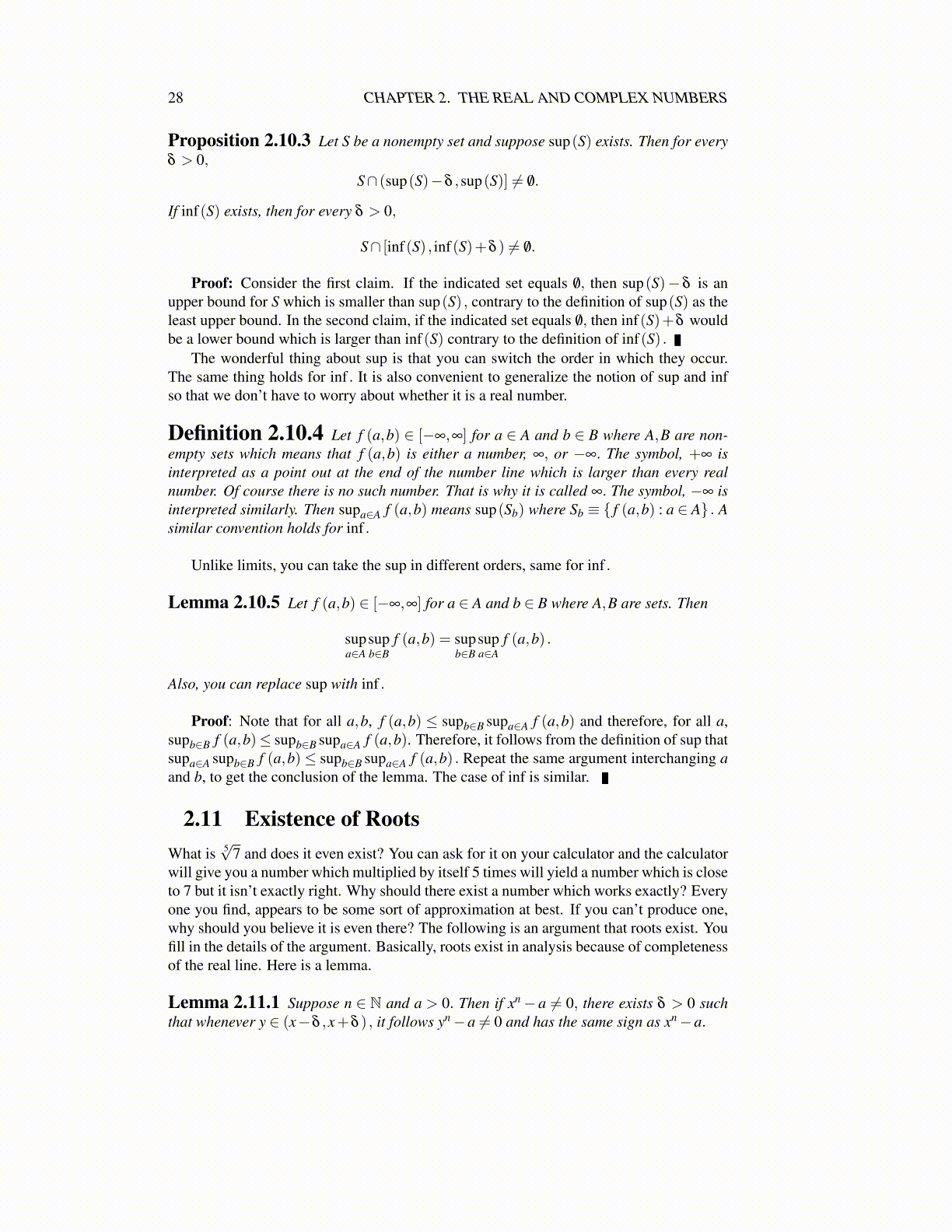
28 CHAPTER 2. THE REAL AND COMPLEX NUMBERS
Unlike limits, you can take the sup in different orders, same for inf .
Lemma 2.10.5 Let f (a,b) ∈ [−∞,∞] for a ∈ A and b ∈ B where A,B are sets. Then
supa∈A
supb∈B
f (a,b) = supb∈B
supa∈A
f (a,b) .
Also, you can replace sup with inf .
Proof: Note that for all a,b, f (a,b) ≤ supb∈B supa∈A f (a,b) and therefore, for all a,supb∈B f (a,b)≤ supb∈B supa∈A f (a,b). Therefore, it follows from the definition of sup thatsupa∈A supb∈B f (a,b)≤ supb∈B supa∈A f (a,b) . Repeat the same argument interchanging aand b, to get the conclusion of the lemma. The case of inf is similar.
2.11 Existence of RootsWhat is 5
√7 and does it even exist? You can ask for it on your calculator and the calculator
will give you a number which multiplied by itself 5 times will yield a number which is closeto 7 but it isn’t exactly right. Why should there exist a number which works exactly? Everyone you find, appears to be some sort of approximation at best. If you can’t produce one,why should you believe it is even there? The following is an argument that roots exist. Youfill in the details of the argument. Basically, roots exist in analysis because of completenessof the real line. Here is a lemma.
Lemma 2.11.1 Suppose n ∈ N and a > 0. Then if xn− a ̸= 0, there exists δ > 0 suchthat whenever y ∈ (x−δ ,x+δ ) , it follows yn−a ̸= 0 and has the same sign as xn−a.
Proof: Let y− x = ε . Then we need to show that if |ε| is small enough,
(xn−a)((x+ ε)n−a)> 0.
From the binomial theorem
(xn−a)((x+ ε)n−a) = (xn−a)
(n
∑k=0
(nk
)ε
n−kxk−a
)
= (xn−a)
((xn−a)+
n−1
∑k=0
(nk
)ε
n−kxk
)≥ (xn−a)2−|xn−a| |ε|
n−1
∑k=0
(nk
)|ε|n−(k+1) |x|k
So let |ε|< min(
1,(|xn−a|
2 ∑n−1k=0
(nk
)|x|k)−1
). Then for |ε| this small,
(xn−a)((x+ ε)n−a) = (xn−a)(yn−a)>(xn−a)2
2> 0
Theorem 2.11.2 Let a > 0 and let n > 1. Then there exists a unique x > 0 such thatxn = a.
Proof: Let S denote those numbers y ≥ 0 such that tn− a < 0 for all t ∈ [0,y]. Nownote that from the binomial theorem,
(1+a)n−a =n
∑k=0
(nk
)ak1n−k−a≥ 1+a−a = 1 > 0